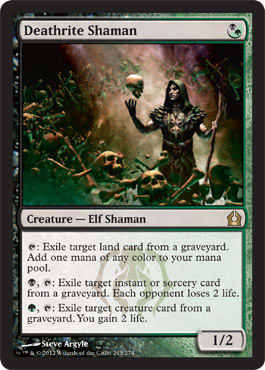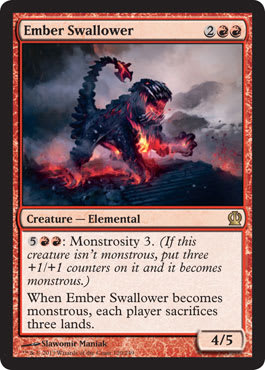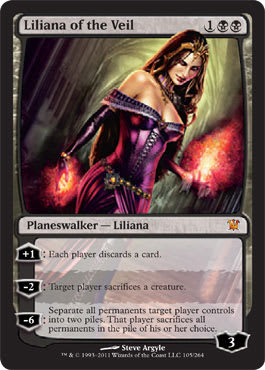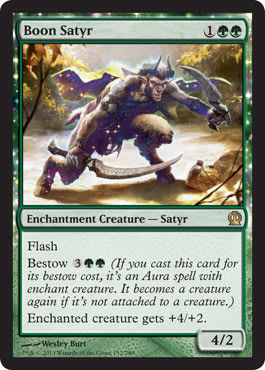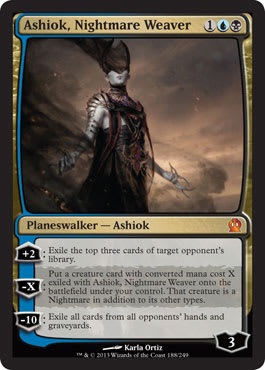Theros is quite the popular set, and it had a lot of very cool and interesting cards for Standard and other formats. Today, instead of talking about the immediate Standard results, I want to help you evaluate these cards. I want touch on key criteria that will help you for every new set and rotation. These same criteria can also be used to shift your stance on old impact cards as well.
How Much Impact Will Mana Make in a Given Format?
When you see a new card, the first thing after reading it is to give a good look at its mana cost. Then, if you think there’s room in a deck for the card, ask yourself if said mana is going to fit into the format, let alone a given deck. There’s a big jump in playability in regard to mana when looking at Standard or Block compared to older formats. You don’t need to necessarily have the optimal card in every slot to succeed.
Judging cards on their merits also becomes much easier when they happen to be dirt cheap. With expensive cards, there’s typically competition for the slots, and there are arguments to be made for lesser cards that are cheaper. Instead, when a card is only 1 or 2 mana, the level of competition drops dramatically, and it becomes a question of whether it has enough impact to be played.
Nobody argued with Deathrite Shaman—because he was only a single hybrid mana, the card couldn’t actually be any cheaper and still see print. As a result, it was easy to pencil him in to every Eternal format as the all-time best Birds of Paradise. Now, if Deathrite Shaman had cost 2 mana or even cost a single color instead of a hybrid, there might be an actual debate about throwing him into a deck.
For more expensive cards, however, there can be a vast gulf between how good a 6-mana card was in a new format compared to how it was in an old one. You would have been laughed out of the room trying to battle with Elspeth, Sun's Champion against Delver decks in other highly-curve-considerate formats. On the other hand, playing her in a format where haymaker Magic is the norm and Titans are at their peak popularity could produce drastically different results.
I saw the power of Elspeth’s abilities and felt they were more than worthy of a 6-mana card; however, the 6-mana cost is historically very rough on planeswalkers. Often, 6-drops have to absolutely dominate a game, and in a new format, making three creatures a turn and having a situational Retribution of the Meek may not fit that criterion.
"W/U Control, Max Tietze, 2nd ? SCG Open Worcester"
- Creatures (1)
- 1 AEtherling
- Planeswalkers (6)
- 2 Elspeth, Sun's Champion
- 4 Jace, Architect of Thought
- Spells (27)
- 1 Celestial Flare
- 1 Essence Scatter
- 1 Quicken
- 2 Dissolve
- 2 Syncopate
- 3 Sphinx's Revelation
- 4 Azorius Charm
- 3 Divination
- 4 Supreme Verdict
- 4 Detention Sphere
- 2 Ratchet Bomb
- Lands (26)
- 8 Island
- 8 Plains
- 2 Mutavault
- 4 Azorius Guildgate
- 4 Hallowed Fountain
- Sideboard (15)
- 1 Celestial Flare
- 3 Glare of Heresy
- 2 Jace, Memory Adept
- 2 Last Breath
- 3 Negate
- 2 Pithing Needle
- 2 Yoked Ox
As it turns out, Elspeth is amazing and possibly the best card in the set for Standard. For me, it’s definitely the best new card—and not returning (hi, Thoughtseize!)—in Theros. While I’m happy I accurately guessed its playability, I’m a little disappointed that I fell into the mana-without-context trap. I knew the format would be slow enough that Sphinx's Revelation decks would be very strong, and Elspeth provided enough options that it could slot into Aetherling’s or the fourth Revelation’s slot.
Based on just that, I should have had a stronger recommendation for the card. Thankfully, Elspeth is a card that, after you play her, it’s obvious you want to continue doing so. Maybe I’m just dumb, though, and you clearly saw that cards such as Stormbreath Dragon and Elspeth, Sun's Champion were auto-includes.
Did you accurately evaluate the playability of Purphoros, God of the Forge and Thassa, God of the Sea? The mana rates for both of those cards are pretty good for their abilities . . . Yet, they had no initial impact despite a lot of hype. It isn’t bad to be weary of newer cards as long as you look at the context of the format and are willing to try them out.
Which brings me to my next criterion.
How Much Does the Format Shape the Value of a Card?
This is probably the simplest and yet most overlooked aspect of evaluating new cards. People love to compare new cards to older ones or still-legal cards changing formats. What this causes is a severe disconnect between reality and the vacuum you’ll be rating the card in.
Ember Swallower is a great example of a card that would’ve had zero chance of seeing play in 2013 summer Standard. A 4/5 for 4 wasn’t impressive in a world where 5/5s for 4 were discarded—and those were cards that had more relevant abilities to boot! Instead, we had a world where Hellrider was the gold standard for attacking decks, Huntmaster of the Fells was for midrange, and Restoration Angel was for everything else.
Compared to these creatures, there’s no way Ember Swallower looks good or could be reasonably expected to make a major impact. In this new post-Theros world, though, I think he’s a very reasonable 4-drop and quite possibly among the best creatures in R/G ramp decks. Why? All these utility and ability-based creatures that outclassed him have left the building, meaning all the combat-stats creatures are left behind.
Adding to that is how the range of removal subtly shifted, and if you aren’t playing black, you have a very limited set of removal that deals with 5 toughness on the cheap. All the sudden, if you play a deck in the majority of the colors, you have to concern yourself with how to deal with a 4/5. If the answer is to ignore it, the monstrosity becomes relevant, and after a few turns, it can outclass whatever you put in the way.
With a power shift downward—alongside the all the premier creatures leaving—we see that games will slow down. As games slow down, cards that let you sink large amounts of mana become better—you’ll draw more lands on average. All of this provides crucial context for the card and allows us to have a better idea of how it fares. Let’s hit on one more example before moving on.
Liliana of the Veil is easily a top-five planeswalker of all time, and it’s arguably in the top three, alongside Jace, the Mind Sculptor and Elspeth, Knight-Errant. If we only count Eternal formats, she probably rates second, just behind Jace. In Standard, she took over a year to see real mainstream play. She had everything she needed, but her abilities simply weren’t relevant in the format that was cultivated at the time.
Many people wrote her off, and others kept trying to fit a square peg into a round hole. Eventually, the format became friendly to her and the kind of attrition war she excelled at, and she became a staple. Lingering Souls is another recent card that falls into this same category—its playability was contingent on what everyone else was doing. Context is everything, and this is why revisiting cards when metagames shift is so important.
When Dealing with New Mechanics, It May Play Better than on Paper, and Vice Versa
Planeswalkers are traditionally among the hardest card types to properly evaluate for any tournament format. Not only are they relatively young for Magic, but they’ve dramatically shifted design-wise at least once—and arguably twice—since their introduction. Compare the original five Lorwyn ’walkers to those produced in Shards of Alara and Zendikar blocks, and then compare those to the ’walkers from Innistrad forward.
It is difficult to evaluate planeswalkers because so much of their power isn’t in their mana or abilities. Instead, a lot has to do with their loyalty costs and how much interaction the opponent can have with them. Sometimes, the only way to know for sure how good a planeswalker can be is to jam one into a bunch of deck shells and start rating its performance.
The same can be said for brand new mechanics. I heavily underestimated Boon Satyr, for example. Bestow seemed to be an overcosted mechanic aimed at Limited, and I simply couldn’t see using it outside of a handful of situations. Then, I actually tried the card out and realized just how much value bestow brought to the card against Supreme Verdict decks. Simply put, it was a major component in how playable the card was that I simply glossed over because I didn’t know enough about the mechanic.
"G/U Madness by David Humphreys"
- Creatures (18)
- 3 Arrogant Wurm
- 3 Wonder
- 4 Aquamoeba
- 4 Basking Rootwalla
- 4 Wild Mongrel
- Spells (20)
- 1 Krosan Reclamation
- 1 Ray of Revelation
- 3 Unsummon
- 4 Circular Logic
- 2 Deep Analysis
- 2 Quiet Speculation
- 3 Roar of the Wurm
- 4 Careful Study
- Lands (22)
- 11 Island
- 8 Forest
- 1 Centaur Garden
- 2 City of Brass
- Sideboard (15)
- 1 Deep Analysis
- 2 Envelop
- 1 Krosan Reclamation
- 2 Mana Leak
- 2 Nantuko Vigilante
- 2 Phantom Centaur
- 1 Ray of Revelation
- 2 Stupefying Touch
- 1 Unsummon
- 1 Wonder
It did help that flashback was also a primary mechanic. Take it as a lesson that you don’t need a linear strategy for a mechanic to be the cornerstone of a deck.
With new mechanics, you sometimes just have to jump in and actually try them out to see how they function. That could even mean making an entirely new deck based around such a card. Affinity and madness are two popular examples from history of mechanics that didn’t seem particularly strong until they reached a critical mass in decks built to abuse them. Dredge is another infamous example of a mechanic very hard to read. People played it in Draft, though, and they came to a much better understanding of how the mechanic would play out. Eventually, this led to Ichorid decks and the scourge of noninteractive Magic in Eternal formats—only known as Dredge.
Money Has No Impact on How Good a Card Is
As Magic grows more popular, the cost of playing slides up, and one of the more common arguments I see raised is one of cost. The most popular argument is, “I think a particular card is good, but not $40 good!” as though this were a meaningful distinction. Saying a card is worse because you don’t think it’s worth its price tag is silly and has no bearing on how that card performs in the real world.
You can have a budget and play Magic. You can have restrictions on deck-building because of your budget. You can’t pretend everyone else is going to handicap themselves because of your financial impediment. The same goes for devaluing the power of cards when you don’t want to or can’t buy them.
Don’t Be Afraid to Have an Opinion and Be Wrong about a Card
You’ll have plenty of time to play with fully streamlined decks and defined metagames in the months ahead. At best, you’ll have a month to really have an edge from having a strong opinion about a card that goes away from the hive mind. If you think Chandra, Pyromaster is really strong, start slotting her in decks and seeing how she performs. If no existing shell works for her, make one or tweak an existing one until she does fit somewhere. Do you think a popular choice is terrible? Don’t play it, and be on a deck that showcases why Stormbreath Dragon doesn’t do anything. (Stormbreath Dragon is an awesome card and used purely for the sake of example.)
I think Ashiok, Nightmare Weaver is a mediocre planeswalker. All 3-mana planeswalkers that have seen major play have the ability to instantly cash in loyalty for a card. It may not be as direct as drawing a card, such as with Jace Beleren or Domri Rade, but Liliana of the Veil does it just the same. Every single one can at least net you a card to replace itself before it’s dealt with.
I think having to wait two turns before generating value out of your planeswalker in most matches is just too much for widespread play. Most people also take it for granted that you need to hit a relevant creature for Ashiok to make an impact. With all that said, it remains very hard to kill, and the creature-stealing ability is strong enough for it to see play in noncontrol matches. I would think of it as a reasonable sideboard card that might see niche main-decked play for now.
Could I be wrong about it? Definitely! Todd Anderson wrote that he thought it was the most underrated card in Theros and that it would make a major impact at the Pro Tour. Sam Black and Zvi Mowshowitz have both come down as seeing the card as quite reasonable. We all have reasonable logic behind our positions, and at this point, it simply comes down to seeing what results bore out. If I’m wrong, I’ll reconsider my position on the matter.
"Esper Control, Jared Boettcher, Top 8 ? SCG Open Worcester"
- Planeswalkers (9)
- 2 Elspeth, Sun's Champion
- 3 Ashiok, Nightmare Weaver
- 4 Jace, Architect of Thought
- Spells (25)
- 1 Far // Away
- 2 Dissolve
- 2 Doom Blade
- 2 Hero's Downfall
- 3 Sphinx's Revelation
- 3 Syncopate
- 4 Azorius Charm
- 4 Supreme Verdict
- 1 Blind Obedience
- 3 Detention Sphere
- Lands (26)
- 1 Swamp
- 2 Plains
- 4 Island
- 1 Azorius Guildgate
- 3 Temple of Deceit
- 3 Temple of Silence
- 4 Godless Shrine
- 4 Hallowed Fountain
- 4 Watery Grave
- Sideboard (15)
- 1 Detention Sphere
- 2 Essence Scatter
- 3 Glare of Heresy
- 2 Last Breath
- 4 Thoughtseize
- 3 Yoked Ox
Ashiok is already making an impact in Esper control decks. Time will tell whether you want to build your deck with Ashiok in mind or simply keep it around as a sideboard threat.
The worst thing you can do is be so committed to being right that you refuse to play cards or archetypes. That hurts your immediate results, and it also hurts your growth as a player—you hamstring your card and metagame evaluations. Arguing with everyone else until the fabric of reality warps around you and you magically become right is not a valid endgame. At some point, you need to reconsider your position and what your response will be to the card in the future. Nobody is going to force you to play it, but you should consider what you’ll do instead and whether that remains valid.
Don’t Let the Results of One Tournament Unduly Influence All Your Future Decisions
Thanks to Magic Online and the constant flood of large cash tournaments, you no longer need to look to one major tournament as the centerpiece of a format. Yes, the Pro Tour will remain a big deal and have a major impact on the immediate metagame. It doesn’t mean the metagame will be stuck like that until a new set comes out.
As I was talking with Josh Utter-Leyton a few weeks ago, he made a great point: Look at the Block decks played at the Pro Tour, and then go take a gander at the Magic Online Block results for the last month. The decks being played now are miles better than what actually saw play. Treat one source of data as exactly that—as one piece of the bigger picture.
Next time, we’ll be back to analyzing Standard, and I hope we’ll have a clearer read on certain decks since Theros will be on Magic Online this weekend. Until then, good luck figuring out the new formats!
Josh Silvestri
E-mail me at josh.silvestri at gmail dot com
















